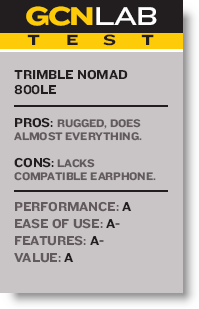It's not a question of what the Trimble Nomad 800LE can do. The real question is what can't it do? The rugged handheld computer has a built-in Global Positioning System receiver that gives longitude, latitude and wind speed. It runs the Windows Office suite. It can take pictures and video. It can scan bar codes. It links to the Internet via Bluetooth, Wi-Fi or a virtual private network. It plays your favorite songs.It sends e-mail. It transcribes your poor penmanship into legible text.And ruggedized is almost too mild a word to describe it; Rambo-ized would be a more accurate description. The Nomad handled every form of abuse the GCN Lab threw at it with nary a blip. We practically played kickball with it, and it still performed its many functions beautifully.The school-bus-yellow unit is a little bigger and heavier than the average BlackBerry personal digital assistant, but the Nomad is packed with features most BlackBerrys don't have. The unit weighs 21 ounces, including a rechargeable battery.Setup was easy. The Nomad's stylus has a Phillips screwdriver at one end, which came in handy. We plopped in the lithium ion battery and screwed the cover tight, and, voil', the Nomad came to life.Charging the device initially was the hardest part of setting up the Nomad. It comes with four different adapters so there's no excuse for not finding a compatible socket. It took a few hours for the indicator light to go green. But that was really the only waiting we had to do. The Nomad's 806 MHz processor made it a zippier computer than many laptop PCs we've used. Once charged, the battery lasted just fine throughout the week or so we spent testing it.The Nomad runs on the Windows Mobile platform, so it comes loaded with Windows Media player, Internet Explorer, PowerPoint, Excel, Word and synchronization capabilities with Outlook e-mail systems.The box includes a CD to help get started and sync e-mail. We also loaded some favorite tunes from Windows Media onto the Nomad, using the included USB connection.This led us to our one real criticism of the Nomad: It didn't include earphones and had a small audio jack. We combed through our whole collection of earphones, and they were all too big for the audio outlet. To listen to our music, we had to hold the Nomad's built-in speaker up to our ear like an old transistor radio. Our suggestion to Trimble: Include earphones that will work with the Nomad in the next version or simply go with a standard-size jack.The transcriber software, however, worked like a charm. Admittedly, when we used the stylus to write 'Works like a charm' on the device, it translated our chicken scratchings as 'Works like a chain.' But that's still a better comprehension level than most people have when they try to read our handwriting.At the top of the unit is a bar code-reading laser light, which cast a powerful red beam when we activated it, using the built-in Scan- Agent tool. User need to download software for their specific bar code application. But ScanAgent still did some rudimentary logging of bar code data. It scanned our driver's license bar code and the bar code on the back of a biography of C.S. Lewis we were reading, and it noted both our driver's license number and the book's ISBN number accurately.The GPS directions and documentation are built into the unit, so there's no fumbling with a paper manual. To test the receiver, we took the Nomad for a stroll around the wooded glen that surrounds the GCN Lab. The unit displayed a graphical representation of the heavens and showed that about 12 satellites were orbiting above us, about half of which were being used, shown in blue.It took a minute or two to register our latitude and longitude. The numbers went up and down in a most gratifying way as we walked east and west, north and south. The Nomad also noted the wind speed, which varied from about 0.8 mph to 6 mph. The temperature was in the mid-30s, and our hands got stiff clutching the Nomad, which wasn't affected at all by the cold.The screen stayed clear and legible despite the bright afternoon sun, which is important, considering the outdoors work that most Nomad users will probably be doing.Back inside the lab, we subjected the Nomad to a series of ruggedness tests.Trimble's literature states that the Nomad series meets the Mil-Std-810F standard for drops, vibration and temperature extremes.We say, amen to that.With no signs of distress, the Nomad ably survived the GCN Lab's rain forest environment test, which consisted of 30 minutes in a sealed box with temperatures of 120 degrees F and 100 percent humidity. We thought the rain forest might at least steam off the removable plastic screen protector that came with the unit, but it didn't.We then dropped the Nomad onto plywood over concrete from various heights, on its front, back, sides, top, bottom and all four corners.At the two-foot drop, the unit bounced a little, especially on the black rubber end pieces.At three feet, the black rubber showed a bit of wear, but the Nomad carried on, its reassuring deep-blue Windows interface still glowing. At five feet, the Nomad was still working fine. Because the bottom of the unit is heavier than the top, the Nomad turned during the fall like a cat falling out of an apartment building, but it always landed just fine.At $2,499, the Nomad is a bargain, if you consider what it would cost to buy all these functions separately ' a GPS, PDA, MP3 player, tablet PC, digital camera and scanner.Anyone who needs to know location ' such as people who work in surveying, construction, fleet management or public safety ' would do well to bring along the Nomad. The multitasking nature of the Nomad would make it a great addition to the toolbox of government employees who work in agriculture, homeland security, transportation, law enforcement or any job that requires data collection outdoors.
Trimble, (541) 750-9200, http://www.trimble.com/ rugged







